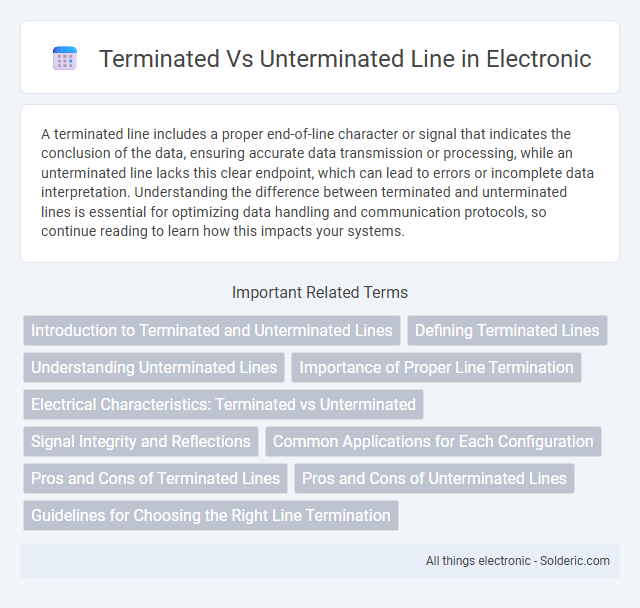A terminated line includes a proper end-of-line character or signal that indicates the conclusion of the data, ensuring accurate data transmission or processing, while an unterminated line lacks this clear endpoint, which can lead to errors or incomplete data interpretation. Understanding the difference between terminated and unterminated lines is essential for optimizing data handling and communication protocols, so continue reading to learn how this impacts your systems.
Comparison Table
| Aspect | Terminated Line | Unterminated Line |
|---|---|---|
| Definition | Line ends with a specific termination symbol or character. | Line continues without a defined termination point. |
| Examples | Lines ending with semicolon (;) in programming. | Lines without semicolon or explicit end marker. |
| Purpose | Clearly separates statements or data segments. | Allows continuation or multi-line statements. |
| Usage | Languages like C, Java, JavaScript. | Languages like Python, YAML, or where indentation defines scope. |
| Parsing | Simplifies parsing and error detection. | Parsing relies on context or indentation. |
| Error Handling | Missing terminator often causes syntax errors. | Flexible but can lead to ambiguous code if misused. |
Introduction to Terminated and Unterminated Lines
Terminated lines use resistors at the end of transmission paths to prevent signal reflection and maintain data integrity, especially in high-speed communication systems. Unterminated lines lack these resistors, causing signal reflections that can lead to noise, data corruption, and communication errors. Proper termination is crucial in minimizing electromagnetic interference and ensuring reliable signal transmission in electronic circuits.
Defining Terminated Lines
Terminated lines in signal transmission refer to cables that include a resistor at the end of the line, matching the characteristic impedance to prevent signal reflections and ensure signal integrity. Proper termination minimizes noise and data distortion, which is critical in high-speed communication systems such as Ethernet or RS-485 networks. In contrast, unterminated lines lack this resistor, leading to potential signal degradation and communication errors.
Understanding Unterminated Lines
Unterminated lines occur when a line of code or data lacks a proper ending character, such as a semicolon or newline, causing syntax errors or incomplete execution. Understanding unterminated lines is crucial for debugging code and ensuring that your programs run smoothly without unexpected interruptions. Proper termination marks signal the end of a statement, enabling interpreters and compilers to correctly parse your code.
Importance of Proper Line Termination
Proper line termination prevents signal reflections and data corruption, ensuring reliable communication in electrical circuits and communication networks. Terminated lines maintain signal integrity by matching impedance, reducing errors and enhancing overall system performance. Your devices function optimally when transmission lines are terminated correctly, avoiding data loss and improving operational efficiency.
Electrical Characteristics: Terminated vs Unterminated
Terminated lines maintain signal integrity by matching the transmission line impedance, minimizing reflections and reducing electromagnetic interference, which results in clearer data transmission and improved overall system performance. Unterminated lines cause signal reflections due to impedance mismatch, leading to noise, signal distortion, and potential data errors in high-speed or long-distance electrical communication. Proper termination is crucial in high-frequency circuits and digital interfaces to preserve signal quality and ensure reliable electrical characteristics.
Signal Integrity and Reflections
Terminated lines use resistors or other components to match the characteristic impedance, minimizing signal reflections and preserving signal integrity. Unterminated lines lack this impedance matching, causing signal reflections that can degrade waveform clarity, increase noise, and lead to data errors. Proper termination ensures your signals remain clean and reliable, especially at high frequencies or long transmission distances.
Common Applications for Each Configuration
Terminated lines are commonly used in high-speed data transmission systems like Ethernet and CAN bus to prevent signal reflections and ensure data integrity over long distances. Unterminated lines are typically found in low-frequency or simple wiring scenarios where signal degradation is minimal and termination is unnecessary, such as in basic control circuits or short interconnections. Choosing the correct line termination enhances system reliability and performance based on signal frequency and transmission distance.
Pros and Cons of Terminated Lines
Terminated lines improve signal integrity by reducing reflections and electromagnetic interference, which enhances data transmission reliability in high-speed communication systems. However, they introduce additional components and slight power loss, potentially increasing costs and complexity in circuit design. Balancing termination benefits with these trade-offs is essential for optimizing performance in digital and analog electronic applications.
Pros and Cons of Unterminated Lines
Unterminated lines offer flexibility in design by simplifying connections and enabling easier modifications in circuit layouts, particularly in high-speed PCB designs where impedance control is less critical. However, lack of termination can lead to signal reflections causing noise, data errors, and degraded performance in sensitive high-frequency applications. Proper analysis of signal integrity is essential to balance the benefits of reduced component count against the risk of compromised signal quality.
Guidelines for Choosing the Right Line Termination
Choose the right line termination based on the specific communication protocol requirements and signal integrity needs. Terminated lines reduce signal reflections and electromagnetic interference, ensuring reliable data transmission in high-speed or long-distance applications. Your decision should consider factors like cable length, frequency, and impedance matching to optimize performance and minimize errors.
terminated vs unterminated line Infographic

 solderic.com
solderic.com